For other uses, see Pentagram (disambiguation).
| Regular pentagram | |
|---|---|
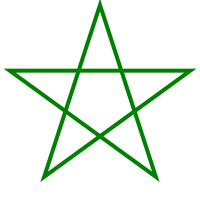 A pentagram | |
| Type | Star polygon |
| Edges and vertices | 5 |
| Schläfli symbol | {5/2} |
| Coxeter–Dynkin diagram | |
| Symmetry group | D5 (Order 10) |
| Internal angle (degrees) | 36° (108°) |
Pentagrams were used symbolically in ancient Greece and Babylonia, and are used today as a symbol of faith by many Wiccans, akin to the use of the cross by Christians and the Star of David by Jews. The pentagram has magical associations, and many people who practice Neopagan faiths wear jewelry incorporating the symbol. Christians once more commonly used the pentagram to represent the five wounds of Jesus.[4][5] The pentagram has associations with Freemasonry[6] and is also utilized by other belief systems.
The word "pentacle" is sometimes used synonymously with "pentagram", and this usage is borne out by the Oxford English Dictionary, although that work specifies that a circumscription makes the shape more particularly a pentacle.[7] Wiccans and Neo-pagans often make use of this more specific definition for a pentagram enclosed in a circle.[8]
Contents[hide] |
[edit] Classification
- The simple five-pointed star is not a pentagram.
[edit] Early history
[edit] Sumer
The first known uses of the pentagram are found in Mesopotamian writings dating to about 3000 BC. The Sumerian pentagrams served as pictograms for the word "UB" meaning "corner, angle, nook; a small room, cavity, hole; pitfall," suggesting something very similar to the pentemychos (see below on the Pythagorean use for what pentemychos means). In René Labat's index system of Sumerian hieroglyphs/pictograms it is shown with two points up.[9] In the Babylonian context, the edges of the pentagram were probably orientations: forward, backward, left, right, and "above".[10] These directions also had an astrological meaning, representing the five planets Jupiter, Mercury, Mars and Saturn, and Venus as the "Queen of Heaven" (Ishtar) above.[10][edit] Pythagoreans
The Pythagoreans called the pentagram ὑγιεία Hugieia ("health"; also the Greek goddess of health, Hygieia[11]), and saw in the pentagram a mathematical perfection (see Geometry section below).The ancient Pythagorean pentagram, with two legs up, represented the Pentemychos (πεντέμυχος "of five sanctuaries"),[12] a cosmogony written by Pythagoras' teacher and friend Pherecydes of Syros.[13][14] It was the "island" or "cave"[13] where the first pre-cosmic-offspring had to be put in order for the cosmos to appear: "the divine products of Chronos' seed [σπέρμα spérma], when disposed in five recesses, were called Πεντέμυχος (Pentemuxos)".[13]
[edit] Wu Xing
Main article: Wu Xing
Wu Xing (Chinese: 五行; pinyin: Wǔ Xíng), the five phases, or five elements, is an ancient Chinese mnemonic and symbolic figure widely known in East Asia and used traditionally in applications such as medicine, acupuncture, feng shui, and Taoism. They are similar to the ancient Greek elements, with more emphasis on their cyclic transformation than on their material aspects. The five phases are: Fire (火 huǒ), Earth (土 tǔ), Metal (金 jīn), Water (水 shuǐ), and Wood (木 mù).The vectors of the overcoming or controlling cycle visually form a pentagram which is commonly incorporated into depictions. Generative and destructive cycles are shown as clockwise and counter-clockwise circular motion.[15]
- controlling cycle
- wood breaks earth, earth absorbs water, water douses fire, fire melts metal, metal splits wood.
- generative cycle
- wood feeds fire, fire makes earth, earth bears metal, metal collects water, water nourishes wood.
- destructive cycle
- wood absorbs water, water rusts metal, metal breaks earth, earth smothers fire, fire burns wood.
[edit] European occultism
Heinrich Cornelius Agrippa and others perpetuated the popularity of the pentagram as a magic symbol, keeping the Pythagorean attributions of elements to the five points. By the mid-19th century a further distinction had developed amongst occultists regarding the pentagram's orientation. With a single point upwards it depicted spirit presiding over the four elements of matter, and was essentially "good". However, the influential writer Eliphas Levi called it evil whenever the symbol appeared the other way up.- "A reversed pentagram, with two points projecting upwards, is a symbol of evil and attracts sinister forces because it overturns the proper order of things and demonstrates the triumph of matter over spirit. It is the goat of lust attacking the heavens with its horns, a sign execrated by initiates."[16]
- "The flaming star, which, when turned upside down, is the hierolgyphic [sic] sign of the goat of Black Magic, whose head may be drawn in the star, the two horns at the top, the ears to the right and left, the beard at the bottom. It is the sign of antagonism and fatality. It is the goat of lust attacking the heavens with its horns."[17]
- "Let us keep the figure of the Five-pointed Star always upright, with the topmost triangle pointing to heaven, for it is the seat of wisdom, and if the figure is reversed, perversion and evil will be the result."[18]
- Man inscribed in a pentagram, from Heinrich Cornelius Agrippa's De occulta philosophia libri tres. The five signs at the pentagram's vertices are astrological.
- The occultist and magician Eliphas Levi's pentagram, which he considered to be a symbol of the microcosm, or human.
[edit] Religious symbolism
[edit] Bahá'í Faith
Main article: Bahá'í symbols
“Strictly speaking the 5-pointed star is the symbol of our Faith, as used by the Báb and explained by Him. But the Guardian does not feel it is wise or necessary to complicate our explanations of the Temple by adding this.”[19]In the Bahá'í Faith, the star is known as the Haykal (Arabic: "temple"), and it was initiated and established by the Báb. The Báb and Bahá'u'lláh wrote various works in the form of a pentagram.[20]
— Shoghi Effendi, Directives from the Guardian, "141: NINE (Number)"
[edit] Christianity
The pentagram is used as a Christian symbol for the five senses,[21] and if the letters S, A, L, V, and S are inscribed in the points, it can be taken as a symbol of health (from Latin salus).[22]Medieval Christians believed that the "pentalpha" symbolizes the five wounds of Christ. The pentagram was believed to protect against demons.[23]
The pentagram figured in a heavily symbolic Arthurian romance:[23] it appears on the shield of Sir Gawain in the 14th century poem Sir Gawain and the Green Knight. As the poet explains, the five points of the star each have five meanings: they represent the five senses, the five fingers, the five wounds of Christ,[24] the five joys that Mary had of Jesus (the Annunciation, the Nativity, the Resurrection, the Ascension, and the Assumption), and the five virtues of knighthood which Gawain hopes to embody: noble generosity, fellowship, purity, courtesy, and compassion.
Most Christians came to associate it with Satanism and subsequently rejected the symbol sometime in the twentieth century.[23][self-published source?]
[edit] Mormonism
The Church of Jesus Christ of Latter-day Saints began using both upright and inverted five-pointed stars in Temple architecture, dating from the Nauvoo Illinois Temple, which was dedicated on April 30, 1846.[25] Other temples decorated with five-pointed stars in both orientations include the Salt Lake Temple, and the Logan Temple. These symbols derived from traditional Morning Star pentagrams that are no longer commonly used by other Christian denominations.[26][edit] Neopaganism
Many Neopagans, especially Wiccans, use the pentagram as a symbol of faith similar to the Christian cross or the Jewish Star of David. Its religious symbolism is commonly explained by reference to the neo-Pythagorean understanding that the five vertices of the pentagram represent the four elements with the addition of Spirit as the uppermost point. As a representation of the elements, the pentagram is involved in the Wiccan practice of summoning the elemental spirits of the four directions at the beginning of a ritual.The outer circle of the circumscribed pentagram is sometimes interpreted as binding the elements together or bringing them into harmony with each other. The Neopagan pentagram is generally displayed with one point up, partly because of the "inverted" goat's head pentagram's association with Satanism; however, within traditional forms of Wicca a pentagram (no circle) with two points up is associated with the Second Degree Initiation and in this way differs from the encircled pentacle inverted of Satanism.[27]
Because of a perceived association with Satanism and also because of negative societal attitudes towards Neopagan religions and the "occult", many United States schools have sought to prevent students from displaying the pentagram on clothing or jewelry.[28][29][30] In public schools, such actions by administrators have been determined to be in violation of students' First Amendment right to free exercise of religion.[31]
The circle around a pentagram (transforming it in to a pentacle) is a symbol of "unity, wholeness, infinity, the goddess, and protection. To earth-centered religions throughout history as well as to many contemporary pagans, it represents the feminine spirit or force, the cosmos or a spiritualism Mother Earth, and a sacred space."[citation needed] The five-pointed star is representative of the four primal elements (earth, air, fire and water,) and traditionally a fifth, called spirit. The circle binds them together to create life. When pointing up, the pentagram can represent spirituality's dominance over the material (pentagram) bound inside the laws of the cosmos (circle). The upside-down facing pentagram, meanwhile, represents the physical world ruling over the spiritual, and has therefore been associated with dark magic. Other sources point to its origin in Chinese five-element philosophy (see feng shui), as the natural balance between fire, water, earth, wood, and metal. This theory states that the direction it is pointing has nothing to do with good or evil, but rather the upside-down facing circle is for banishing. The circle is again for the concept the power within is bound by, this time for the circle of life.[32]
[edit] Satanism
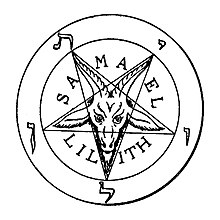
A goat's head inscribed in a downward-pointing pentagram, from La Clef de la Magie Noire by the Rosicrucian Stanislas de Guaita (1897).
[edit] Thelema
Aleister Crowley also made use of the pentagram and in his Thelemic system of magick: an adverse or inverted pentagram represents the descent of spirit into matter, according to the interpretation of Lon Milo DuQuette.[33] Crowley contradicted his old comrades in the Hermetic Order of the Golden Dawn, who following Levi considered this orientation of the symbol evil and associated it with the triumph of matter over spirit.[edit] Political symbolism
[edit] Flags
While a solid five-pointed star is found on many flags, the pentagram is relatively rare. It appears on two national flags, those of Ethiopia and Morocco and in some coats of arms. According to Ivan Sache, on the Moroccan flags, the pentagram represents the link between God and the nation.[34] It is also possible that both flags use the pentagram as a symbol of King Solomon (see Seal of Solomon), the archetypal wise king of Jewish, Christian and Muslim lore, although the six-pointed Star of David is a more common and more widely accepted symbol. In either case, the pentagram is a traditional symbol of both the Moroccan and Ethiopian peoples, and, within Morocco, is also a symbol of the Alaouite dynasty.[edit] Other organizations

Order of the Eastern Star emblem
[edit] Order of the Eastern Star
The Order of the Eastern Star, an organization associated with Freemasonry, has employed a point-down pentagram as its symbol, with the five isosceles triangles of the points colored red, blue, yellow, white and green. This is an older form of the order's emblem and it is now more commonly depicted with the central pentagon rotated 36° so that it is no longer strictly a pentagram.[edit] In literature
In the medieval romance of Sir Gawain and the Green Knight, the pentagram on Gawain's shield is given a Christian interpretation (see above).In Goethe's Faust, the pentagram prevents Mephistopheles from leaving a room.
- Mephistopheles:
- I must confess, my stepping o'er
- Thy threshold a slight hindrance doth impede;
- The wizard-foot doth me retain.
- Faust:
- The pentagram thy peace doth mar?
- To me, thou son of hell, explain,
- How earnest thou in, if this thine exit bar?
- Could such a spirit aught ensnare?
- "... Ah, how do all my senses leap at this sight! I feel the young and sacred pleasure of life quivering in my nerves and veins. Was it a God who traced this sign which stills the vertigo of my soul, fills my poor heart with joy, and, in a mysterious rapture, unveils the forces of Nature around me? Am I myself a God? All is so clear to me: I behold in these simple line the revelation of active Nature to my soul. I realise for the first time the truth of the wise man's words: The world of spirits is not closed! Thy sense is obtuse, thy heart is dead! Arise! Bathe, O adept of science, thy breast, still enveloped by an unearthly veil, in the splendours of the dawning day!" (Faust, Part i.sc.i).[35]
In T. S. Eliot's The Dry Salvages, reference to pentagrams is made in part V, verse 8:
- By sortilege, or tea leaves, riddle the inevitable
- With playing cards, fiddle with pentagrams
- Or barbituric acids, or dissect
- The recurrent image into pre-conscious terrors[...]
In Japanese culture, the pentagram (五芒星 gobōsei) is a symbol of magical power, associated with the onmyoji Abe no Seimei; it is a diagram of the "overcoming cycle" of the five Chinese elements. As a predominantly non-Christian country, with a different set of associations attached to the symbol, there is no social stigma associated with it.
[edit] Geometry

A pentagram colored to distinguish its line segments of different lengths. The four lengths are in golden ratio to one another.
[edit] Construction
The pentagram can be constructed by connecting alternate vertices of a pentagon; see details of the construction. It can also be constructed as a stellation of a pentagon, by extending the edges of a pentagon until the lines intersect.[edit] Golden ratio
The golden ratio, φ = (1+√5)/2 ≈ 1.618, satisfying[edit] Trigonometric values
[edit] Three-dimensional figures
Several polyhedra incorporate pentagrams:[edit] Higher dimensions
Orthogonal projections of higher dimensional polytopes can also create pentagrammic figures:| 4D | 5D | ||
|---|---|---|---|
 The regular 5-cell (4-simplex) has 5 vertices and 10 edges. |  The rectified 5-cell has 10 vertices and 30 edges. |  The rectified 5-simplex has 15 vertices, seen in this orthogonal projection as 3 nested pentagrams. |  The birectified 5-simplex has 20 vertices, seen in this orthogonal projection as 4 overlapping pentagrams. |
[edit] In Astronomy and nature
 Successive inferior conjunctions of Venus repeat very near a 13:8 orbital resonance (The Earth orbits 8 times for every 13 orbits of Venus), creating a pentagrammic precession sequence. |
[edit] In visual arts
- The artist Martina Schettina uses pentagrams in her paintings.[36] The painting "Golden Pentagram" was shown at the Museumsquartier in Vienna in 2010.[37]
- Artist William Powhida employed pentagrams in his 2010 performance Surviving the Art World Using the Art of Sorcery at Hyperallergic in Brooklyn, NY. The artist performed curses that promised to "induce a favorable Friday New York Times review," "be paid within ninety days or three moons," "ward off annoying bloggers," or "beat your high estimate at auction."[38]
- The metalcore band Oh, Sleeper uses a "broken" pentagram with the top two triangles or "horns" missing, representing the downfall of Satan.



























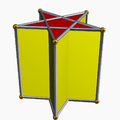
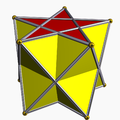




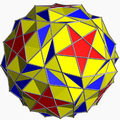


Tidak ada komentar:
Posting Komentar